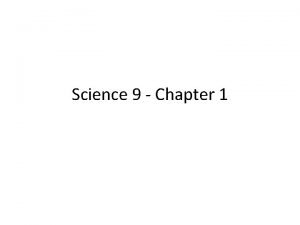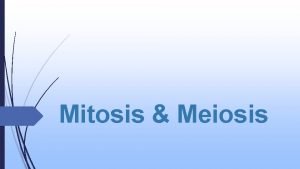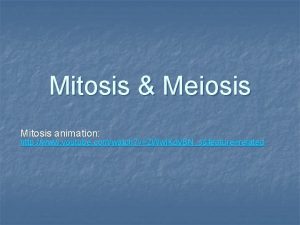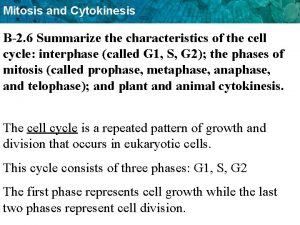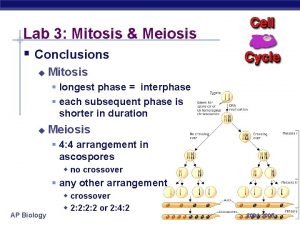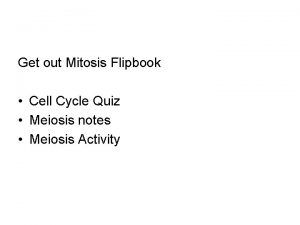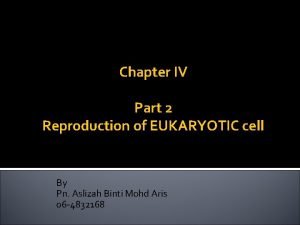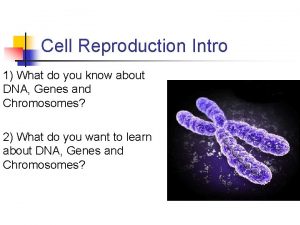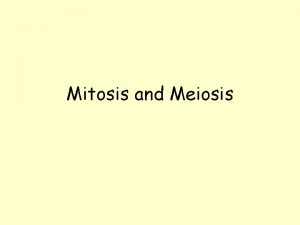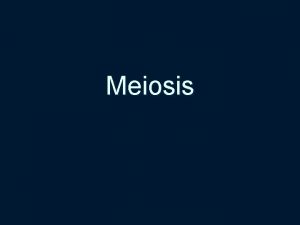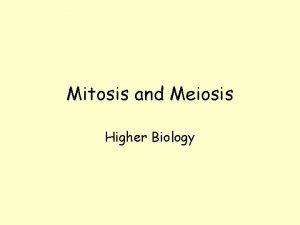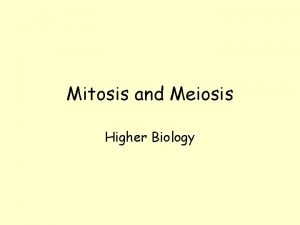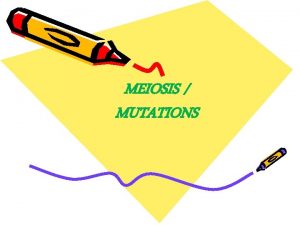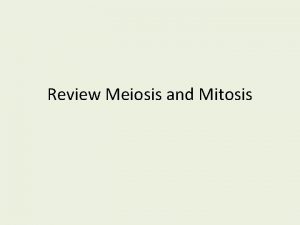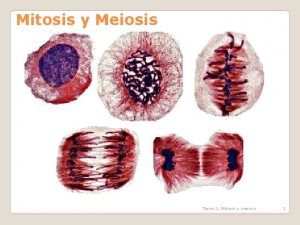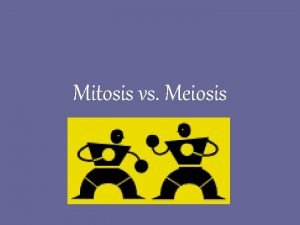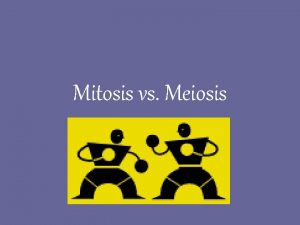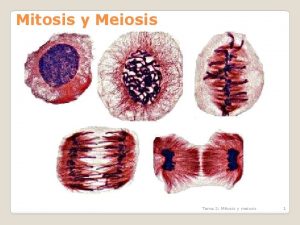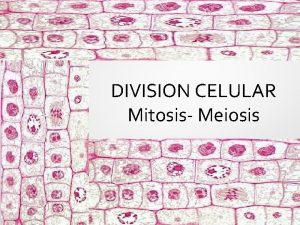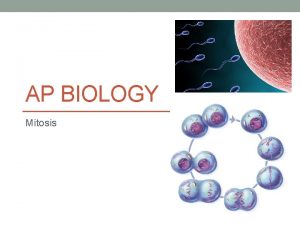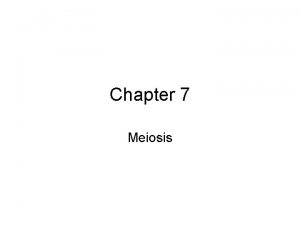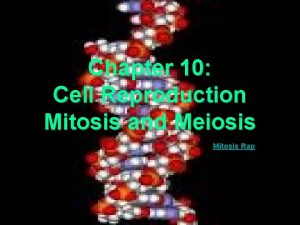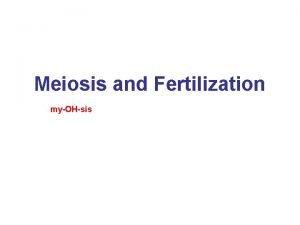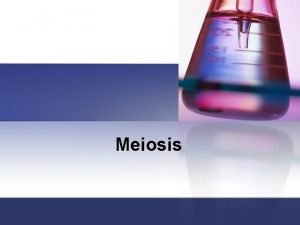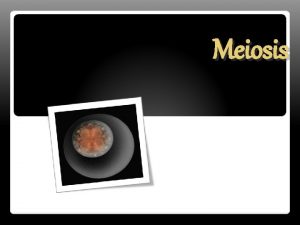Chapter 11 and 12 Mitosis and Meiosis Mitosis





















- Slides: 21

Chapter 11 and 12 Mitosis and Meiosis Mitosis • One cell division • Produces 2 identical cells • Used for growth, tissue repair, and asexual reproduction • • • Meiosis Two cell divisions DNA replicates once Produces 4 haploid cells Provides variation Primary purpose: Gamete production

The Cell Cycle The cell cycle is a complex set of stages that is highly regulated with checkpoints, which determine the ultimate fate of the cell. 1. Interphase consists of three phases: a) growth b) synthesis of DNA c) preparation for mitosis 2. The cell cycle is directed by internal controls or checkpoints. a) Internal and external signals provide stop-and-go signs at the checkpoints.

Regulation of Cell Cycle • Mitosis-promoting factor (MPF) • Action of platelet-derived growth factor (PDGF) • Cancer results from disruptions in cell cycle control • Cyclins and cyclin-dependent kinases control the cell cycle.

More Mitosis Facts Mitosis alternates with interphase in the cell cycle. When a cell specializes, it often enters into a stage where it no longer divides, but it can reenter the cell cycle when given appropriate cues. – Non-dividing cells may exit the cell cycle; or hold at a particular stage in the cell cycle.

Mitosis passes a complete genome from the parent cell to daughter cells. 1. Mitosis occurs after DNA replication. 2. Mitosis followed by cytokinesis produces two genetically identical daughter cells. 3. Mitosis plays a role in growth, repair, and asexual reproduction 4. Mitosis is a continuous process with observable structural features along the mitotic process

I) Eukaryotic Chromosomes A) Form highly condensed pairs of chromosomes 1) Homologous Chromosomes – chromosomes with the same genes, same size, same appearance a) Genes are located at the same location (locus) b) c) d) e) f) g) b) Homologous chromosomes may contain different forms of the same genes (dominant or recessive forms) These forms of genes are called ALLELES

B) Sex Chromosomes and Autosomes 1) Sex chromosomes (X or y) contain genes that determine gender 2) Autosomes contain genes that determine traits other than gender 3) Humans cells contain 44 autosomes and 2 sex chromosomes


C) Haploid vs. Diploid vs. Polyploid Haploid – cells with ½ normal number of chromosomes Gametes (sex cells) “n” number In humans n=23 Diploid – cells with the normal number of chromosomes Body cells (somatic cells) “ 2 n” number In humans 2 n = 46 Polyploid – cells with more than the normal number of chromosomes Cells can have an extra set or more 3 n, 4 n, 6 n, 8 n

The Cell Cycle

I) Three Parts of the Cell Cycle A. Interphase – cell grows and performs its usual functions 1) G 1 (Gap 1) – growth and metabolism 2) S (Synthesis) – DNA Replication begins 3) G 2 (Gap 2) – DNA replication complete B. Mitosis – division of genetic material 1) Four phase process (awesome animation!) 2) Form two new nuclei C. Cytokinesis – division of the cytoplasm to form two new cells 1) Cell Plate (in plants) forms a new cell wall 2) Cleavage Furrow (in non-plants) pinches to split cells a) Syncytium – cell with 2 nuclei when cytokinesis does not occur (syncytia is plural form)



II) When do Cells Divide? A. When cell size becomes too large and surface-area-to-volume ratio decreases 1) Some cells divide once a day, once a week, once a lifetime 2) Nerve cells, red blood cells, muscle cells divide until the differentiate

III) Control of Cell Division A. Growth Factors – proteins that bind to plasma membrane receptors and trigger mitosis (can be hormones) B. Hormones – Steroid hormones bind to DNA via nuclear hormone receptor proteins C. Cyclin – protein that activates enzymes to initiate replication 1) Stimulates transcription and replication factors

C. Important Proteins in the Cell Cycle 1) Ras Cyclin – verifies cell is proper size 2) P 53 – Tumor Suppressor Protein checks DNA for damage before replication a) Stops cell cycle if DNA is damaged b) Many cancers associated with a defective p 53 gene 3) MAD 1 – Verifies spindles attach to kinetochore


IV) Cancer A) Cells that grow abnormally B) Three key features of cancerous cells 1) Rapid cell division 2) Undifferentiated 3) Angiogenesis – signal blood vessel growth C) Genetic Causes 1) Mutations in genes a) Tumor Suppressor Genes q normally inhibit cell growth by suppressing mitosis b) Proto-oncogenes – genes that signal cell growth to occur (code for growth factors, hormones, RNAi)

Chapter 12: Meiosis I) Meiosis (Reduction Division) – Gametogenesis – gamete formation II) Meiosis, followed by fertilization ensures genetic diversity in sexually reproducing organisms. A. Two Cell Divisions 1) Meiosis I I. III. IV. DNA replication Synapsis and Tetrad Formation Cross overs of chromosomes Two cells produced 2) Meiosis II I) III) NO replication DNA divides into 4 cells Produce haploid cells

II) Purpose of Meiosis A) Adaptation for the following: 1. Maintain consistent chromosome numbers for sexual reproduction 2. Provide variation through genetic recombination a) form new gene combinations through shuffling chromosomes and crossingover

III) Problems with Meiosis A) Non-Disjunction 1. Chromosomes fail to properly separate after meiosis I 2. Polyploidy results from non-disjunction 3. Polyploid Conditions a) Down Syndrome – trisomy 21 b) Patau Syndrome – trisomy 13 c) Edwards Syndrome – trisomy 18 d) Klinefelter’s Syndrome – XXY e) Supermale - XYY
 Crossing over occurs during
Crossing over occurs during Chapter 10 section 1 meiosis answer key
Chapter 10 section 1 meiosis answer key Chapter 10 section 1: meiosis
Chapter 10 section 1: meiosis Differentiate between chromosome and chromatid
Differentiate between chromosome and chromatid Animal and plant reproduction venn diagram
Animal and plant reproduction venn diagram Difference between mitosis and meiosis
Difference between mitosis and meiosis Anaphase
Anaphase Meiosis 1
Meiosis 1 Telophase
Telophase Whats the difference between mitosis and meiosis
Whats the difference between mitosis and meiosis Kesler science crossword answer key
Kesler science crossword answer key How are somatic cells different from gametes
How are somatic cells different from gametes Cell division concept map
Cell division concept map Mitosis meiosis animation
Mitosis meiosis animation Characteristics of mitosis and meiosis
Characteristics of mitosis and meiosis Diploid vs haploid number
Diploid vs haploid number Respirometer
Respirometer Mitosis flipbook
Mitosis flipbook Chromosome number of animals
Chromosome number of animals Chromosome sets (=n) in mitosis and meiosis
Chromosome sets (=n) in mitosis and meiosis Characteristics of mitosis and meiosis
Characteristics of mitosis and meiosis Cell division mitosis and meiosis
Cell division mitosis and meiosis




